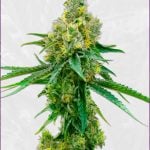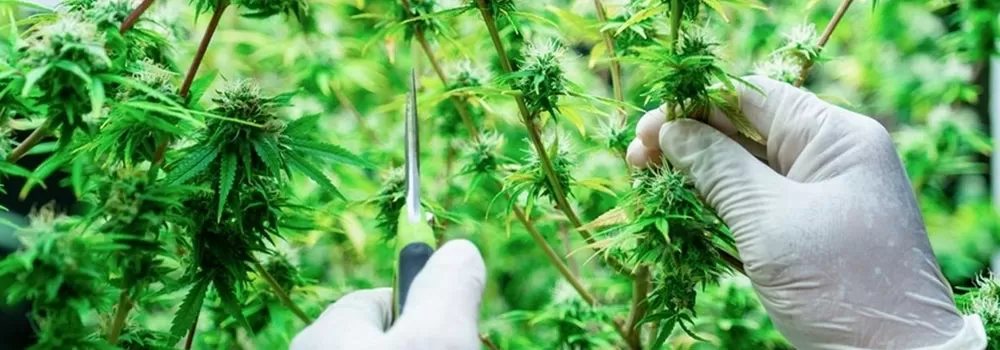Indoor growers has an abundance of techniques for plant training that can increase cannabis yields, such as LST, topping/FIMing, manifolding, ScrOG, and more. Different growers have named and developed these methods over time, which can be confusing due to the variety of names and the complexity or time consumption of some techniques. However, the basic idea behind any marijuana plant training technique is to create a flat, wide table-top shape for the plant canopy with numerous colas or bud sites. Despite the various methods available, they all share this common goal.
This shape is important to ensure that each primary bud receives sufficient light and air, resulting in the growth of long, thick buds and higher yields. Plant training can increase yields by up to 40% compared to no training techniques.
During the vegetative stage of marijuana growth, it is essential to encourage the development of numerous bud sites in a wide, flat, table-top shape. Several methods exist to achieve this, but it’s crucial not to have too many colas as they can start competing for space, resulting in smaller buds. It’s recommended to provide each cola with enough breathing room of 2-3 inches (5-8 cm) between each one to ensure optimal yields. It’s also vital to fill the space under the grow light with as many colas as possible, as any space without buds can waste light that could otherwise increase yields.
Creating many long colas is crucial as they produce the largest, longest, and densest buds. This blog will teach you how to succeed in plant training without complicated techniques, making it simple and easy.
Cannabis Plant Training Made Easy
Let’s skip all the complicated techniques and focus on the fundamental principles of plant training. However, before we proceed, it’s crucial to understand the definition of a “cola,” an informal term used by cannabis growers to describe the main stem or growth tip that has reached the top of the plant canopy and developed into a budding site.
During the vegetative stage, colas resemble regular stems with growth tips at the end, but they are labeled as “main” stems since they have made it to the top of the canopy. In the flowering stage, these stems produce the largest and longest buds, which is why growers aim to develop as many colas as possible.
Tip #1: Select notable growth tips and cultivate them into colas
Any growth tip has the potential to develop into a cola if it is provided with ample light and air. The objective is to cultivate growth tips near the base of your plant to ensure that many of them reach the top canopy. It is not necessary to use any special techniques to achieve this goal. The only thing you need to do is to ensure that the growth tips you want are exposed to direct light and air.
Simply bending and tucking your leaves out of the way to expose the growth tips to direct light can make a significant difference. Some growth tips will naturally become bigger and more prominent than others, and it is best to work with your plant instead of going against it. If your plant appears to favor a specific growth tip, it is an excellent candidate to nurture into a cola.
While some cannabis growers choose to “top” their plant by cutting off the top when it is young to create two main stems at the bottom, this is a matter of preference. You can obtain excellent results by merely bending the main stem without cutting the plant.
Tip #2 Select colas originating from the main stem’s lower part
If feasible, opt for colas that originate from lower on the plant, closer to the base of the main stem. Typically, the best stems extend down to the bottom of the plant, and for some reason, the plant directs more energy towards these stems, resulting in larger buds than those that sprout higher up on the plant.
It is worth noting that this concept forms the basis of methods such as manifolding, in which every cola originates from the same spot on the primary base. However, you do not need to create a manifold to boost your yields.
Tip #3 Bend the stems in the right direction
When bending stems, it is advisable to only bend the parts of the stem that are flexible, which are usually located near the ends. Avoid bending any part that has become stiff or woody, as these parts will likely snap.
In the event that you need to bend a woody stem, take extra precautions to prevent the skin of the stem from splitting. Begin by grasping the part of the stem that requires bending between your fingers and squeezing it tightly. Next, slowly and gently wiggle the stem, applying pressure to the stem as hard as possible while wiggling. Crushing the inside of the stem will make it more pliable without breaking the skin, reducing its resistance. Once the stem becomes flexible, that is the ideal time to bend it. Refrain from attempting to bend it if it still feels stiff! This technique is commonly referred to as “super cropping,” but it is essentially just a way to bend a stiff stem.
To bend a particularly rigid stem, start by firmly pinching the stem between your fingers (not nails). Squeeze the stem while gently wiggling it back and forth where you want it to bend. Continue doing this until you feel or hear crunching from the inside of the stem. It may take several seconds of wiggling to get the stem to become flexible. Slowly bend the stem at the new joint you have created and secure it in place.
Don’t worry too much if you accidentally snap a stem and break the skin while attempting to bend it over. Vegetative plants have a remarkable ability to recover from injuries. If you quickly wrap the injured area with duct tape or electrical tape, similar to a “cast,” your cannabis plant will be able to repair the broken stem. Within a week or two, a “knuckle” will form at the injured site, and you will be able to remove the tape. The stem will be as good as new!
Tip #4: Bend taller colas to even out the height with others
To ensure an even canopy, it’s important to monitor the height of your plant’s colas regularly. If you notice any colas growing taller than the others, gently bend them down and away from the base of the plant. Doing this early before the stem becomes too stiff to bend is best. This technique is especially effective when you bend the stem towards an area with no other buds under direct light. This helps fill any gaps in the canopy.
Regular monitoring and adjustment of your plant’s colas will help maintain an even canopy, allowing all parts of the plant to receive adequate light and air.
Tip #5: Check if stems are secured
If you fail to secure the stems of your plants after bending them, they may revert to their original position and resume growing from there. This can happen quite quickly, sometimes even overnight. To avoid this, it’s best to use something soft and pliable to secure the stems, like plant twisty ties. These ties are designed for plant use and won’t harm your plants or cut into the skin.
You can attach the twisty ties to anything, but using the container of the plant works particularly well, as it will help maintain the plant’s shape even if you need to move it. When using hydroponics, it’s recommended to attach the twisty ties directly to the lid of the container to avoid disturbing the plant when moving the lid. Similarly, when growing in a pot, it’s best to attach the twisty ties directly to the lip of the pot, as it will allow you to move the plant more freely.
Plant twist ties can be easily found online or in the gardening section of physical stores. If you’re unsure what to look for, you can ask for plant ties, often used to secure vines.
Tip #6: Make sure to arrange the buds
In order to achieve optimal yields, it’s important to ensure that each cola has enough room to grow during the flowering stage. This means leaving at least 2-3 inches (5-8 cm) of space around each cola, allowing for ample space between the colas. Additionally, it’s best to have as many colas as possible under the light.
During the vegetative stage, it’s recommended to regularly assess the plant for any “holes” or areas without colas under the light. If any are found, select a cola from around the edges or a nearby growth tip and gently nurture, train, or bend it to fill the space. The plant can produce the best possible yields by filling all of the space under the light.
To fill empty spots in the canopy, bend one of the colas from around the edges down and into the space. If you need help determining the empty spots, look for areas where the canopy appears less dense or where there’s a visible gap.
Tip #7: Eliminate non-cola stems before transitioning to flowering
To ensure optimal growth of your plant, it’s important to keep the main stems arranged in the top canopy. However, as the plant grows and approaches the flowering stage, you’ll likely notice smaller, less developed stems underneath the main canopy. These undeveloped stems, sometimes called “suckers,” will divert energy away from the larger buds you want your plant to focus on.
It’s recommended to remove these suckers that won’t ever make it to the top and will only produce small, airy buds while taking away valuable resources from the main colas. No small stems should be competing with the colas for light and space. Advanced growers may even remove most or all of these underdeveloped stems for the best results.
Just before transitioning your plant to the flowering stage, it’s best to remove any stems that didn’t make it to the top and won’t receive direct light. This process is sometimes called “lollipopping” the plant. These parts of the plant that are in darkness will only divert energy away from the main colas and will only produce small, low-quality buds. Removing them will allow the plant to focus its energy on the main colas, resulting in larger, higher-quality buds.




























